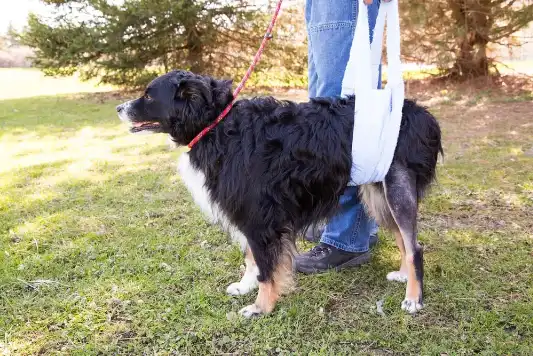PET HEALTH
A cranial cruciate ligament (CCL) injury in dogs is similar to an anterior cruciate ligament (ACL) injury in humans. These orthopedic injuries are common and often result from gradual degeneration rather than sudden trauma. Since CCL ruptures can’t heal on their own, surgery is necessary. One effective option is tibial plateau leveling osteotomy (TPLO) surgery, which could cost between $2,000 and $5,000.1
Read on to learn about TPLO surgery, recovery time, and how to care for your dog after the procedure.
MetLife Pet Can Help You Cover TPLO Surgery Costs
What Is TPLO Surgery for Dogs?
To understand TPLO in dogs, it’s important to know what the CCL is. The CCL is one of two ligaments connecting the shin bone (tibia) and the thigh bone (femur) at the knee joint (stifle). Along with the caudal cruciate ligament (CaCL), it forms a cross shape within the joint, providing stability and proper alignment. This is why they’re called “cruciate ligaments.”2
When a cranial cruciate ligament tears, the femur slides forward into the tibia, causing pain and potentially leading to osteoarthritis. TPLO surgery restructures the knee in a way that makes the CCL unnecessary. In a TPLO procedure, the tibia is adjusted until it’s level and can stabilize the dog’s knee.2
During this type of canine surgery, a veterinary surgeon makes a semicircle slice through the tibia and rotates the top portion to level it with the femur. They’ll then attach a metal bone plate and screws to hold the two pieces of the cut tibia in place. This allows the tibia to heal in a new position and restore stability to the joint.2
After surgery, your dog may stay overnight at the veterinary clinic for monitoring and recovery from anesthesia.
What causes CCL ruptures in dogs?
CCL ruptures in dogs often result from gradual wear and tear rather than sudden trauma. Factors that contribute to this degeneration include:3
- Age: Older dogs are more susceptible due to prolonged stress on the ligament.
- Breed: Certain breeds — like Labradors, Rottweilers, and Newfoundlands — have a higher predisposition to CCL ruptures.
- Weight: Overweight dogs place additional stress on their joints, increasing the risk of rupture.
- Activity level: High-impact activities and sudden movements can exacerbate ligament wear and tear.
- Conformation: Some dogs have a naturally steep tibial plateau angle, which often puts extra strain on the CCL.
Symptoms of a torn CCL in dogs
There are many signs of a CCL injury in canines. If your dog has a torn CCL, you may notice the following symptoms:3
- Limping or lameness: Your pup may avoid putting weight on the affected leg or have a noticeable limp.
- Stiffness: This may be especially evident after your dog rests or first thing in the morning.
- Difficulty rising or sitting: Your dog may struggle with movements that involve bending their knee joint.
- Swelling around the knee joint: The stifle area may appear swollen or feel warm to the touch.
- Reduced activity levels: Your dog may be reluctant to play, run, or jump as they normally would.
- Instability in the leg: Your dog’s leg may appear unstable or give out during movement.
Is TPLO Surgery Worth It for Dogs?
When a veterinarian recommends TPLO surgery for your dog, it’s important to take their advice seriously. A torn CCL is painful, and if left untreated, it can cause irreparable damage to the knee and may lead to osteoarthritis.2
The reason is a torn CCL can cause tibial thrust as your dog walks. When your dog puts weight on the torn knee, the tibia can slide forward from the femur. This motion can be painful, damaging the cartilage and surrounding bones.4
While many surgeries aim to repair the torn CCL, TPLO surgery configures the knee to work without it to restore mobility in the joint.4
What Does Canine TPLO Surgery Recovery Look Like?
Recovery from TPLO surgery is a gradual process requiring patience and careful management. Immediately after surgery, your dog may need to stay at the veterinary clinic overnight for monitoring. Most dogs will start bearing weight on the affected leg within 24 hours, but full recovery can take up to 12 – 16 weeks.4
The first 2 weeks are crucial for healing, as this is when the incision needs the most protection.2 During this period, you’ll need to limit your dog’s activity to prevent complications.4 Swelling and mild discomfort are common, but these should decrease over time.
During your dog’s recovery, you’ll notice increased mobility and strength in the leg that was operated on. By the end of the recovery period, many dogs can return to their normal activities, but it’s important to follow your vet’s recommendations throughout the healing process.
Tips To Help Your Dog Recover From TPLO Surgery
Recovering from TPLO surgery can be challenging for some dogs, but with the right care, your dog can heal successfully. Here are some ways you can help your dog recover post-surgery:
- Follow recovery instructions: Adhere to the instructions your vet gave you for rehabilitation, including administering medications, keeping the incision clean, restricting activity, and following any recommended physical therapy exercises.2,4
- Prepare your home: Set up a comfortable, quiet space for your dog to get rest. A soft dog bed and mentally stimulating toys can help keep them comfortable. If you have other pets, consider keeping them separate to prevent excitement and potential injury.
- Limit physical activity: To avoid complications, restrict your dog’s physical activity for at least 4 months after the operation.2 Encourage stillness and avoid letting your dog jump, run, or engage in any strenuous activity during their recovery period.4
- Protect the incision: Use an Elizabethan collar (a cone) as recommended for up to 2 weeks post-operation. This helps prevent them from licking and biting the incision and supports proper healing.
- Administer pain medications: Give your dog the prescribed pain medications or sedatives according to your vet’s instructions. Pain management is crucial for a comfortable recovery, even if your dog doesn’t show obvious signs of discomfort.2
- Perform physical therapy: Engage in any prescribed physical therapy exercises recommended by your vet.2 Range-of-motion exercises, and eventually leash walks, can help strengthen your dog’s healing knee.3
- Provide mental stimulation: Since physical activity will be limited, it’s important to keep your dog mentally engaged with food-dispensing toys or interactive puzzle toys. This can help prevent boredom and keep their mind active.
- Consider supplements: Ask your vet about supplements that can aid in recovery, such as glucosamine for joint health, or others that reduce inflammation, boost their immune system, and strengthen their healing joints.
How Much Does TPLO Surgery Cost?
TPLO surgery, like other cruciate ligament injury surgeries, could cost around $2,000 – $5,000.1 However, this can vary depending on your dog’s size, breed, and the location of the veterinary clinic. The vet bill may also include diagnostic tests, such as X-rays to assess the extent of the injury, pain medications, hospitalization costs, and follow-up appointments.2,3
While the cost of TPLO surgery can be significant, it’s one of the most effective ways to address a torn CCL and improve your dog’s quality of life.
Injuries like this can make dog health insurance worth it. MetLife Pet’s coverage typically includes CCL ruptures and can help you afford the care your pup needs. A MetLife Pet policy can also help with recovery costs, such as pain medication and physical therapy.
How MetLife Pet helped a real pet family
Dollie, a young dog from Montana, was limping and whining whenever she tried to put weight on her right hind leg. Her owners brought her to the vet, where Dollie was diagnosed with a CCL tear.
Dollie’s veterinarian recommended immediate TPLO surgery to stabilize her knee, and they kept her overnight for the first stretch of her recovery.
The vet bill for surgery and hospitalization was about $2,900, but MetLife Pet Insurance reimbursed Dollie’s family nearly $2,400 thanks to their dog insurance policy.5
Prepare for Your Dog’s TPLO Surgery and Beyond
TPLO surgery can help restore your dog’s mobility and improve their quality of life. If you’re considering TPLO surgery for your dog, pet insurance can provide valuable support in managing the costs of veterinary care. With the right coverage, you can focus on helping your dog heal and know you’re prepared for unexpected expenses.
Take the first step toward peace of mind, and get a free quote for pet insurance today.


